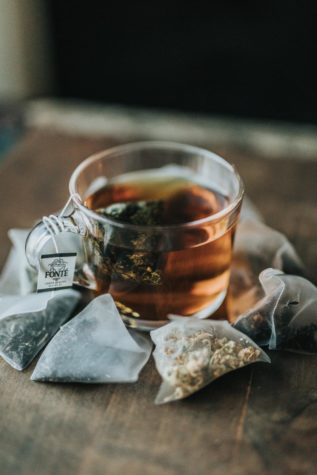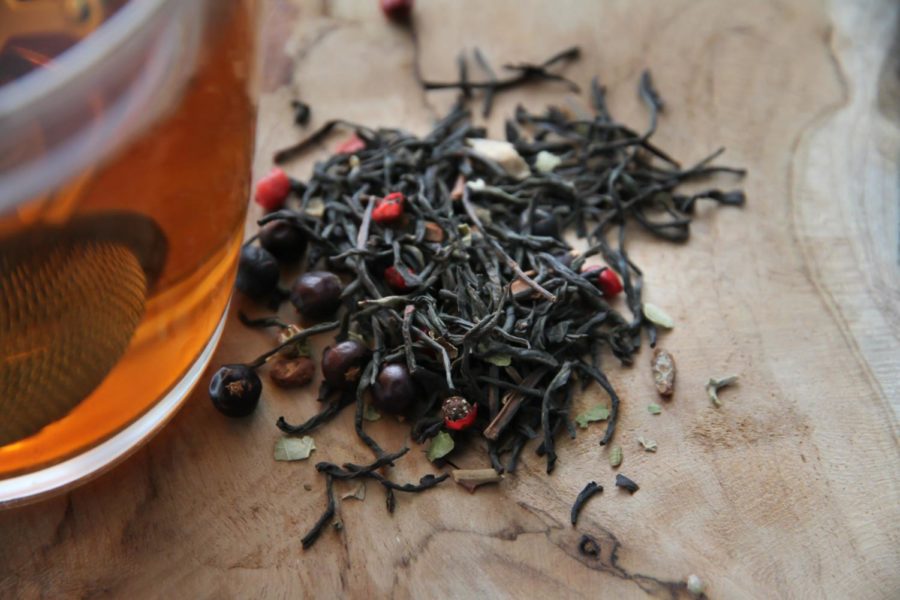The History of Tea
People have been drinking tea for centuries, and it remains a significant part of daily life for millions. How did a drink that was once for a selected few became a worldwide mainstay?
Loose tea is generally preferred amongst tea connoisseurs, as loose tea is of higher quality.
Tea has become entrenched in the daily routines of millions. Like coffee, it is a popular beverage that people drink all over the world. From herbal tea to bubble tea, it has become an immensely popular drink throughout many different cultures and ages.
“I enjoy drinking tea while I work because it can help get me into the right mindset to work more productively. There is also a wide variety of different teas to fit different moods, so I can pick the type of tea I want based on how I’m feeling,” said Katrina Tablang ’23.
While tea consumption today is often associated with English culture, the first records of drinking tea were found in ancient China during the third century C.E. in a text written by Hua Tuo.
Tea also features in the legend where Emperor Shennong is drinking a cup of boiled water when a leaf blows into his cup. Realizing its unique taste upon drinking the water, he discovered tea. A variation of this legend includes Emperor Shennong discovering tea to be an effective antidote while using his own body to test different herbs. Another legend depicts Shennong, the Chinese god of agriculture, chewing on different herbs to figure out their medicinal properties and using tea leaves as an antidote.
Tea was first used as medicine in the Han dynasty. It was during this time that tea leaves were added to boiling water. Hua Tuo, a famous Chinese physician wrote, “to drink bitter t’u constantly makes one think better,” and scholars speculate that t’u could be a reference to tea and its medicinal properties. While tea may have originated in China, it rapidly grew in popularity in many other countries such as Great Britain.
Charles II was deep in debt when he ascended to the British throne on May 29th, 1660. To resolve this crisis, he married Catherine of Braganza, demanding a large dowry of money and luxury goods such as tea from Portugal. It was then that tea was introduced to British high society. As Queen Catherine was a trailblazer, many other aristocrats followed her and slowly developed a taste for tea.
Tea parties were increasingly popular in Great Britain from the seventeenth to the nineteenth century. From high tea to afternoon tea, peasants to aristocrats, everyone in Great Britain drank tea. Regardless of your social status, tea became closely associated with their way of life. Various types of tea parties were held with each with separate specific rules to follow. High tea, despite its name, was a tea party for laborers and was held on a high table, hence its name. Afternoon tea, on the other hand, was also known as low tea and was served on a low table. Unlike its name, it was generally fancier and was used during a lady’s social gathering.
Great Britain was not the only country that greatly appreciated tea and incorporated the beverage into its culture. Many other countries such as Korea, Japan, India, Portugal, Italy, Iran, Taiwan, America, Sri Lanka, Australia, and Africa also held a deep admiration for tea. Some of these countries even held elaborate tea ceremonies, the most well-known being China, Japan, and Korea.
In Japan, tea ceremonies are known as chanoyu which means “hot water for tea.” They follow a ritual known as the way of tea, also known as Chadô. Tea has experienced rising popularity in Japan around the 16th century. Before this time, tea was used as a medicinal drink that was enjoyed by monks and samurais, and it was not easily accessible to the average person. Around the late 1400s to early 1500s, Murata Shuko, the father of tea ceremonies, transformed tea tasting into a relaxing event akin to meditation. During the Meiji era, more women studied the art of tea, as it was included in the apprenticeship to be a maiko or a geisha.
These tea ceremonies were held in pavilions or chashitsu surrounded by a lush garden. To evoke humility, the doors were purposely placed low to make guests bend down before entering. During the tea ceremonies, the host would welcome the guests at the edge of the garden silently and ask guests to wash their hands and rinse their mouths before entering the pavilion.
After entering, the guest would then kneel down on tatami mats and eat a light meal alongside several small desserts. The host would then clean the tools used in the tea-making process with a silk cloth as the water boils.
To make the tea, the host would add matcha powder to the bowl before adding hot water. Afterward, the host would whisk it until it is frothy.
The tea was first served to the guest of honor who would take 3 sips from the bowl before passing it to the next guest, who follows the same pattern. Once this process is complete, the host would then clean the utensils and lead the guest out. This was a very lengthy and time-consuming process that could take up to 4 hours.
Such events were seen as relaxing events where both the host and the guests relax and enjoy the tea and atmosphere. In these events, the host would prepare and serve the guests tea alongside light snacks. This tea was almost always equipped with loose tea.

Tea didn’t always come prepackaged in filter paper bags. Teabags were originally created with silk. While Thomas Sullivan may have popularized the use of tea bags in 1908, he was certainly not its inventor. The history of tea bags dates back to the Tang dynasty when wrapping paper was used to preserve tea leaves.
Before Sullivan, many other inventors also came up with the idea of a teabag, such as Mary McLaren and Roberta Lawson, who were the first to patent a tea bag called the Tea Leaf Holder. Many other similar patents like the Tea Leaf Infuser, Teabag System, and the Tea Brewing Containment Device were also filed before Sullivan’s tea bag use.
In fact, it is believed that the use of teabags was completely accidental. As a New York merchant, Sullivan sent his customers tea samples in small silk bags. While there were no explicit instructions to dip the whole tea bag into the water, his customers chose to do so, and this method quickly caught on.
Many tea connoisseurs prefer loose tea as opposed to tea bags, however. This is because loose tea is generally of higher quality compared to tea bags. Teabags contain tea dust, as well as smaller broken tea leaves, while loose tea uses whole leaves. Furthermore, smaller, broken tea leaves deteriorate much more quickly than whole leaves.
Teabags also restrain the movement of the tea leaves, making it harder for the leaves to release their full flavor potential. In addition, it is easier to adjust the strength of loose tea by adjusting the amount of tea used.
While using loose tea now may seem like the obvious choice, there are also some drawbacks. Loose tea is generally more expensive, and steeping is more time-consuming than using tea bags, making it less convenient.
Pyramid-shaped tea bags are an effective method of combating the restrictiveness of typical bags. Through their unique shape, pyramid tea bags allow water to flow more efficiently, allowing the leaves to infuse faster into the water.
Other tea bags are bought separately, allowing consumers to insert loose tea into these bags to adjust the strength of the tea, while also simplifying the process of removing the tea leaves.
Many Bronx Science students prefer bagged tea over loose tea. “It is more convenient,” said Jason Lin ’23.
Tea has transformed from a medicinal drink in ancient China to the tea we know today. Tea has remained a popular beverage for centuries, and it will no doubt be enjoyed for centuries more to come.
“I enjoy drinking tea while I work because it can help get me into the right mindset to work more productively. There is also a wide variety of different teas to fit different moods, so I can pick the type of tea I want based on how I’m feeling,” said Katrina Tablang ’23.
Khado Tsephel is a Copy Chief for ‘The Science Survey.' In her free time, she enjoys reading and listening to music. In college, Khado wants to pursue...











